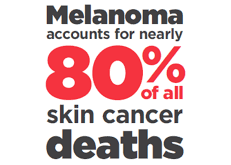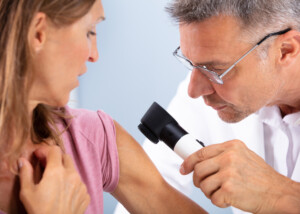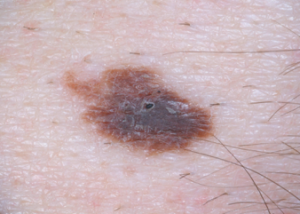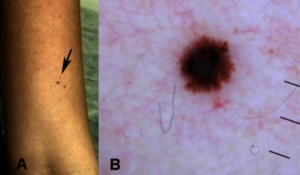
Tiny melanoma, 1.6 mm. Source: Dermatol Pract Concept. 2013 Apr. Copyright ©2013 Pellizzari et al.
Articles and pamphlets refer to melanoma as the “ugly duckling” or “ugly mole.”
But how “ugly” or “different” can a tiny melanoma look if it’s only 1 mm or even half a mm?
“The ‘ugly duckling’ rule is a good guideline for evaluating changes in a mole, but as with most sets of rules, exceptions exist,” says Emily de Golian, MD, a board certified dermatologist with Forefront Dermatology in Atlanta, GA.
“The ugly duckling idea refers to a mole that stands out as looking different from the other moles on someone’s body.”
The term is not to be taken literally, even though many images of melanoma show a sinister-looking skin legion.
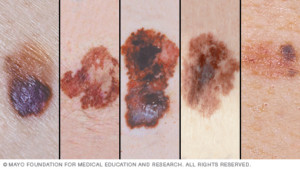
Dr. de Golian continues, “Most people make similar moles throughout their body, but if one of these moles does not fit their usual mole pattern, or ‘signature nevus,’ it may be a sign that the mole is atypical.
“Other good guidelines include the ABCDEs of melanoma, which refer to asymmetry, border (irregular), color (multiple shades), diameter (greater than a pencil eraser) and evolution (change over time).
“The more of these features that are present, the more likely that mole is to be atypical.”
Atypical Moles
“Atypical mole means that the mole cells are showing some degree of unusual features under the microscope,” says Dr. de Golian.
“Mild atypia is unconcerning for development into melanoma, but since severe atypia has the potential to evolve into melanoma, these moles are usually completely removed with a margin of normal skin.
“Moderately atypical moles have uncertain potential for evolution into melanoma, and depending on the mole, may sometimes be monitored versus completely removed.”
But what about tiny tiny melanomas? Just what do they look like?
“Very early melanomas may be small enough that changes consistent with the ABCDEs or ugly ducking rule are not yet apparent, but usually, these features develop as the lesion grows,” says Dr. de Golian.
So if you develop any new “mole” that’s very small, keep an eye on it.
It may grow larger (which doesn’t mean it’s melanoma), but as it gets bigger in size, it’ll be easier for you to see if anything about it looks suspicious, such as a jagged border or a black color when all your moles are tan or medium brown.
“A board certified dermatologist will often examine moles using a dermatoscope, which allows visualization of features that cannot be seen with the naked eye and may alert the dermatologist to suspicious changes.”
Those scary “ugly” images (no magnification) you’ve seen of melanoma are not of tiny spots.
Many are at least the size of a pencil eraser. Many are even bigger, as evident by either a ruler being placed alongside it, or a zoomed-out image of it on the patient’s body.
“If a spot is in question, the safest move is to schedule an appointment with a board certified dermatologist,” says Dr. de Golian.
